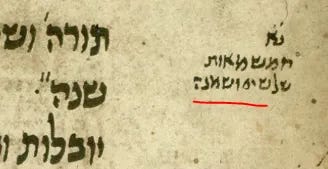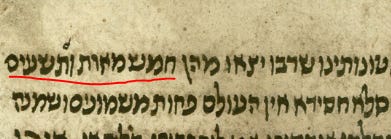Texts are fixed, while human speech is dynamic. If I wrote down the date, even if it was accurate when I wrote it, it would no longer be accurate tomorrow. If you asked me the day of the week, I could tell you, and each time I responded, it would be updated and accurate. Now, while Ravina and Rav Ashi redacted the gemara and gave it its approximate final content, the gemara was still transmitted orally for centuries via a Garsan / “Reciter”. Only in Geonic times was it finally written down, amid much controversy. As we discussed recently in this column (“Lending Out My Midrash Says”), Oral Law shouldn’t be written down, but there is as argument of עת לעשות לה' הפרו תורתך.
In Avoda Zara 9a, Rav Pappa (a fifth-generation Amora) says that if a Tanna forgets the year, he should ask a Scribe and add twenty years; if a Scribe (who dates official documents) forgets the year, he should ask a Tanna and subtract twenty. A Tanna is often an Amora who recites Mishnayot and braytot; alternatively, this Tanna of the preceding brayta who said וַחֲשׁוֹב כַּמָּה שָׁנִים that dates are henceforth calculated from the Temple’s destruction.
Following Rav Pappa is another brayta of the Academy of Eliyahu: “The world will exist for six thousand years. For two thousand, the word was tohu vavohu, waste; another two thousand are the period of Torah; the last two thousand are the days of mashiach. However, בַּעֲוֹנוֹתֵינוּ שֶׁרַבּוּ יָצְאוּ מֵהֶן מַה שֶּׁיָּצְאוּ מֵהֶן – due to our many sins, what has been been taken from them has been taken from them.” The meaning of this last statement is that we are already in potentially messianic times. Mashiach hasn’t arrived yet, so we are eating into those two thousand years.
Dating the Brayta
When was this brayta composed? Rabbi Yehuda HaNasi passed away in 217 CE, which would be 23 years before the 2000 years of Mashiach. Following his generation was a transitional generation between Tannaim and Amoraim, and these late or quasi-Tannaim authored various Tannaitic works. If so, the statement בַּעֲוֹנוֹתֵינוּ שֶׁרַבּוּ יָצְאוּ מֵהֶן could work.
Ketubot 106a relates Eliyahu HaNavi would regularly visit Rav Anan (a second-generation Babylonian Amora who was Shmuel’s primary student. Eliyahu taught him Seder deEliyahu. If this is an early version of the braytot of the Academy of Eliyahu, then we’re working with a later date. Rav Huna, his contemporary, lived between 216 and 297 CE, so we can see how the brayta noted the onset of the span of messianic days.
Now, this brayta in Avoda Zara does not record a fixed year. We have יָצְאוּ מֵהֶן מַה שֶּׁיָּצְאוּ מֵהֶן. Yet, this doesn’t appear to be original. In the parallel sugya in Sanhedrin 97b, while the printed text has this expression, many manuscripts express a specific year! This is because the brayta was meant to be recited orally, so when a Tanna / reciter of braytot, or a Garsan / reciter of Talmud, got to this point, he adjusted the calculation to express how many years into past 4000 had elapsed. This number was impossible to adjust in a manuscript, so the Scribe wrote down his current year, and each copyist was to adjust the year.
The Years in Manuscripts
Here are a few manuscripts and the dates they list. Florence 8-9 and Karslruhe Reuchlin 2 just have יָצְאוּ מֵהֶן מַה שֶּׁיָּצְאוּ מֵהֶן. In the main text, Yad HaRav Herzog has 590, which, adding 240 to convert to secular years, is 830 CE. Yet, in the margin, it records a variant of 538, meaning 778 CE. Meanwhile, Munich 96 gives the elapsed years as 619, meaning 859 CE. Note that Munich 95 is a complete Talmud, yet it does not list a date in the Avoda Zara parallel. Vatican 171 has 889 years, meaning 1129 CE.
We often know when scribes wrote particular manuscripts. For instance, colophons written by scribes, often at the end of the manuscript, give production details, such as who commissioned it, the date, and the name of the sofer. The manuscript dates are later than the elapsed dates above.
Thus, Yad HaRav Herzog is a Yemenite manuscript from the 16th century. Munich 95, our only complete manuscript of Bavli, has colophons dating it to 1342. Vatican 171 is a Byzantine manuscript from 1492/3 by the scribe Yitzchak, containing Chagiga and 11 pages of Sanhedrin. The Sanhedrin pages were copied by a different scribe in Sephardic semi cursive script.
This means that at some point, scribes stopped updating the elapsed years written in their source manuscript. It stands as an artifact indicating the date of one manuscript in the chain. Yad HaRav Herzog, at 778 CE, is the earliest attested date for a written Talmudic text.
While early “elapsed” dates are interesting, I wouldn’t necessarily grant an earlier “elapsed-date” manuscript greater authority than its rivals. Where scribes kept the year text fixed, this might indicate ignorance – they didn’t realize the tradition was to update it. Meanwhile, if there were more years of copying, and therefore perhaps more intermediate textual copies, between the elapsed date and the writing date, there are more opportunities for a scribe to incorrectly copy the text.






I feel so privileged to read your researched articles.
Regarding “However, בַּעֲוֹנוֹתֵינוּ שֶׁרַבּוּ יָצְאוּ מֵהֶן מַה שֶּׁיָּצְאוּ מֵהֶן – due to our many sins, what has been been taken from them has been taken from them.”
As I remember you mentioned another time that you were a Levi; also considering I am not acquainted with you, therefore you have no obligation to answer my question.
Notwithstanding, I seem to be gifted with chutzpah to ask: Regarding Haftaros Shabbos HaGadol, [question:] Is there a compelling reason that It begins with verse (4) of Malachi Chapter (3)?
Because of the current events and troubles of Israel, etc.,
The first three verses have been my mind’s background continually for a while.
I did wonder if a Levi would care to describe experiential evidence of this purification—
any testimony of how HKBH has made one kadosh.